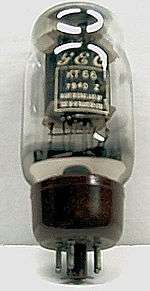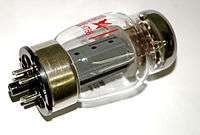KT66
KT66 is the designator for a beam tetrode vacuum tube introduced by Marconi-Osram Valve Co. Ltd. (M-OV) of Britain in 1937.
| KT66 | |
|---|---|
 Original G.E.C./M.O.V. version of the KT66 Beam-Power Tetrode tube; this is an example from late production | |
| Classification | Beam-Power Tetrode |
| Service | Class-A amplifier, (single-ended) Class-AB amplifier, (push–pull) |
| Cathode | |
| Cathode type | Indirectly heated |
| Heater voltage | 6.3 |
| Heater current | 1.27A |
| Anode | |
| Max dissipation Watts | 25 |
| Max voltage | 500 |
| Socket connections | |
Octal Base, (IO)
| |
| Typical class-A amplifier operation | |
| Anode voltage | 250 |
| Anode current | 85mA |
| Screen voltage | 250 |
| Bias voltage | −15 |
| Anode resistance | 22K Ohms |
| Typical class-AB amplifier operation (Values are for two tubes) | |
| Anode voltage | 400 |
| Anode current | 62.5mA (Includes Screen Current) |
| Screen voltage | 400 |
| Bias voltage | −38, (Class AB1) |
| References | |
| Super Radiotron Valve Manual, Amalgamated Wireless Valve Co. Australia, June 1962 Radio Valve Data, Eighth Ed. Ilife Books Ltd., London, 1966 | |
Overview
The KT66 is the direct descendant of the "Harries Valve" developed by British engineer J. Owen Harries and marketed by the Hivac Co. Ltd. in 1935. Harries is believed to be the first engineer to discover the "critical distance" effect, which maximized the efficiency of a power tetrode by positioning its anode at a distance which is a specific multiple of the screen grid-cathode distance. This design also minimized interference of secondary emission electrons dislodged from the anode.
EMI engineers Cabot Bull and Sidney Rodda improved the Harries design with a pair of beam plates, connected to the cathode, which directed the electron streams into two narrow areas, which caused the electron beams to act like a virtual suppressor grid to deflect some secondary electrons back to the anode. The beam tetrode design was also undertaken to avoid the patents which the giant Philips firm held on power pentodes in Europe. Because this overall design eliminated the "tetrode kink" in the lower parts of the tetrode's voltage-current characteristic curves (which sometimes caused tetrode amplifiers to become unstable), M-OV marketed this tube family as the "KT" series, standing for "kinkless tetrode".
A number of different KT tubes were later marketed by M-OV. Some, but not all, were versions of existing American beam tetrode tubes or European power pentodes, such as the KT66 (6L6 similar), KT77 (EL34 and 6CA7 similar), KT88 (6550), and KT63 (6F6, pentode but almost identical characteristics).
Although the RCA 6L6 of 1936 (the result of a license agreement between RCA and M-OV) was the first true "beam power tube" on the market, the later KT66 became almost equally famous, at least in Europe. The two tubes were nearly interchangeable, except that the KT66 was somewhat more rugged than the early metal 6L6.

The KT66 was very popular in European radios and audio amplifiers. It was the standard output tube in the classic Quad II (1952, a version of which is still being manufactured today) and in the LEAK Type 15 (1945) and TL/12 (1948), both among the earliest British hi-fi amplifiers. Because of their excellent electrical characteristics and overload tolerance, KT66s are preferred by some guitar players for use in guitar amps in place of 6L6GC. However, the plate dissipation of the 6L6GC, at 30W, exceeds the KT66's 25W, and adjustment of the amplifier's bias is necessary.
M-OV ceased glass vacuum tube manufacturing in 1988; their old audio tube types became valuable collectibles. In 2004 original M-OV KT66 tubes (bearing the official "Genalex" marketing brand that M-OV used outside the UK), unused in original carton, sold for US$250. As of 2012 KT66 tubes continued to be manufactured at Reflektor Saratov in Russia, JJ Electronic in Slovakia, and at Liuzhou in China.
Some modern Russian manufacture Sovtek KT66 tubes are actually 6L6GC tubes in a KT66 style bottle. While these tubes have the same pinout and minimum tolerances required of a KT66 tube, they do not have the performance characteristics of a true kinkless tetrode KT66 tube.
By contrast the very latest Russian manufactured tubes (2012) not only carry the same internal electrode structure as the original KT66 (they now look the same) they also have the same rugged electrical characteristics and can withstand a high voltage on grid 2 comparable to the anode voltage rating, allowing greater power output afforded by higher voltage capability when run in ultralinear connection.
References
- Barbour, Eric. "History of the 6L6" in Vacuum Tube Valley, issue 4 (1996), p. 3.
- Schade, O. H. "Beam Power Tubes" in Proceedings of the IRE, February 1938.
- Stokes, John. 70 Years of Radio Tubes and Valves. Vestal Press, NY, 1982.
- Thrower, Keith. History of the British Radio Valve to 1940. MMA International, 1982, p. 59.